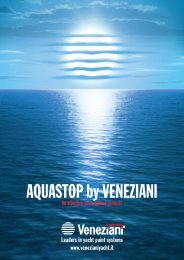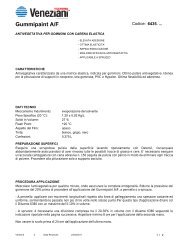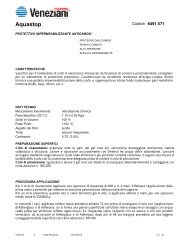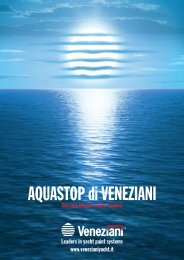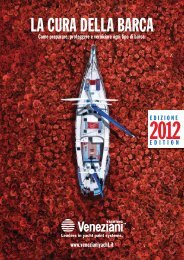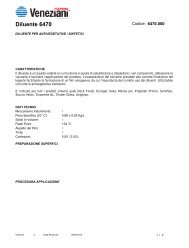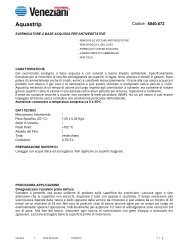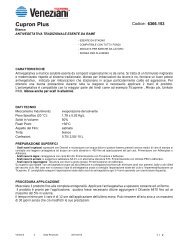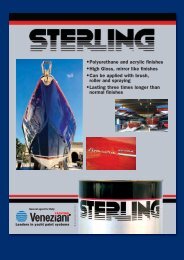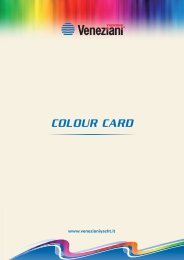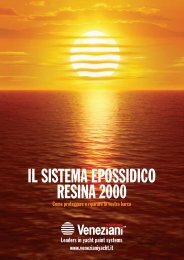3 - Veneziani Yacht Paints
3 - Veneziani Yacht Paints
3 - Veneziani Yacht Paints
Create successful ePaper yourself
Turn your PDF publications into a flip-book with our unique Google optimized e-Paper software.
3 PAINTING YOUR BOAT<br />
PREPARING A BOAT FOR REPAINTING<br />
AQUASTRIP<br />
Water based stripper<br />
for antifoulings<br />
CHARACTERISTICS<br />
Water based, biodegradable<br />
stripping gel specifically formulated<br />
for removing old antifoulings<br />
from wood, GRP,<br />
steel and other metals.<br />
Being water based it does<br />
not damage gel coats or<br />
GRP and can be handled<br />
without harm or risk.<br />
Aquastrip requires longer<br />
softening times if compared<br />
to solvent based strippers,<br />
but is effective on large surfaces<br />
applying only one coat<br />
without danger for the boat,<br />
the operators and the environment.<br />
It has good stripping<br />
power also on one-pack<br />
primers, undercoats and finishes.<br />
Aquastrip does not<br />
contain toxic or harmful<br />
components, has a neutral<br />
pH and can be used indoors<br />
without special ventilation.<br />
Attention: storage at temperature<br />
upper 4°C.<br />
12<br />
TECHNICAL DATA<br />
Specific weight:<br />
0,95 +/- 0,02 Kg/L<br />
Colour: light green<br />
Packaging: 0,75 L/5,00 L<br />
APPLICATION<br />
Apply with: brush - spatula<br />
Thinner:<br />
water for cleaning only<br />
DFT per coat: depending<br />
on surface condition<br />
Theoretical coverage per<br />
coat: 1,0 - 1,5 m 2 /L<br />
When repainting your boat, you must<br />
follow some preliminary steps to clean<br />
it and to ensure that any remaining<br />
layers of paint are still closely bound<br />
to the surface. If the old paint is deteriorating<br />
or delaminating it must be<br />
completely removed or it will cost you<br />
more wasted time and money at a later<br />
date.<br />
After removing all the layers, clean and<br />
wipe down the surfaces which should<br />
now be “as new” and ready to be treated<br />
according to the painting systems<br />
for new boats.<br />
To keep your boat in good condition,<br />
we recommend that you completely remove<br />
the old painting system from the<br />
hull at least once every four years.<br />
DETERSIL<br />
Emulsifying detergent<br />
for silicone<br />
CHARACTERISTICS<br />
Detersil is an emulsifying<br />
detergent for silicones. To<br />
obtain maximum adhesion<br />
of paint to GRP surfaces<br />
without the need of sanding,<br />
it is necessary to remove first<br />
all mould- release agents.<br />
Since these agents contain<br />
wax, paraffin or silicone, a<br />
special detergent must be<br />
used. Detersil has a dissolving<br />
and emulsifying action<br />
and can be used whenever<br />
a surface has to be cleaned<br />
thoroughly before painting.<br />
TECHNICAL DATA<br />
Specific weight:<br />
0,93 +/- 0,02 Kg/L<br />
Solids by volume: 44%<br />
Colour: clear<br />
Packaging: 1,00 L<br />
APPLICATION<br />
Apply with: brush - swab<br />
Thinner:<br />
water for cleaning only<br />
Theoretical coverage per<br />
coat: 30,0 m2 /L<br />
CLEANING AND INSPECTION<br />
Follow the cleaning programme below:<br />
• wash with fresh water, with a<br />
pressure-jet if possible, to thoroughly<br />
clean all the surfaces;<br />
• degrease only areas affected by<br />
mineral oils, using a sponge<br />
soaked in DETERSIL, and rinse.<br />
Check that the old layer of antifouling<br />
is well bonded;<br />
• larger areas can be stripped with<br />
mechanical means such as scrapers<br />
or disc sanders - which are<br />
quite slow procedures - or with a<br />
portable heater - suitable only for<br />
one-pack coatings - or with chemical<br />
strippers. Chemical strippers<br />
may be divided in two categories:<br />
acid or solvent based strippers are<br />
corrosive liquids, which in contact<br />
with skin may cause burns or ulcers.<br />
These strippers, after application,<br />
should be removed as soon<br />
as the coating has been softened,<br />
otherwise the substrate could be<br />
damaged.<br />
Water based strippers are gels,<br />
which can be handled without risk<br />
or danger. These strippers require<br />
a longer reaction time, but have<br />
the same effectiveness as the<br />
previously mentioned ones. One<br />
should always use water based<br />
strippers such as AQUASTRIP formulated<br />
by <strong>Veneziani</strong>.<br />
The information given is a summary of the technical data sheets, for more details please contact the MTD.<br />
STRIPPING<br />
(Only for deteriorated surfaces)<br />
To remove old, deteriorated antifoulings<br />
use AQUASTRIP, a water<br />
based, biodegradable stripping gel,<br />
which does not damage gel coats<br />
or GRP, penetrates deeply into the<br />
coating layer and is effective on<br />
large surfaces, saving time and<br />
work. AQUASTRIP has good stripping<br />
power also on one-pack primers,<br />
undercoats and finishes.<br />
Proper stripping is carried out as<br />
follows:<br />
• Apply a wet coat with a thickness<br />
of 1 mm (about one can of 0,75 L<br />
for 1 m 2 , or one can of 5,00 L for 6<br />
- 7 m 2 );<br />
• Let the stripper act for a few<br />
hours (also during a whole night if<br />
the temperature is not too high);<br />
• Remove the softened layer with a<br />
spatula. Often the removal can be<br />
carried out with a pressurized water<br />
jet;<br />
• Do not carry out stripping with<br />
strong wind or in strong sunlight.<br />
If the layer of antifouling is very<br />
thick repeat the above procedure.<br />
Use mechanical means for the removal<br />
only if no AQUASTRIP is available.



